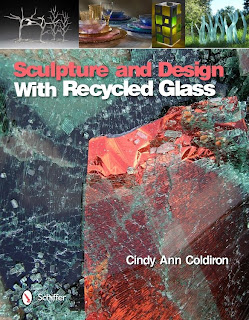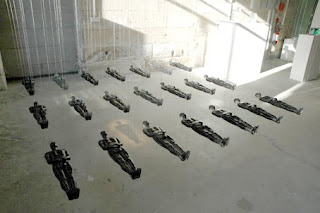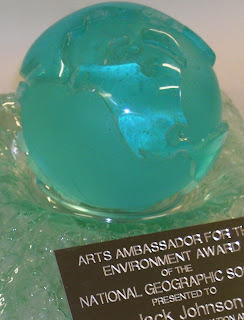>

There are some great works and images of projects, including works by DC area artists Nikki O’Neill, Bill Hess and Cindy Ann Coldiron.

“Glass on Stone”
Erwin Timmers, 120″ x 20″ x 2″, kiln cast recycled window glass
photo by Anything Photographic
Our Erwin Timmers‘ environmental themed artwork has an attractive spread in the book. Erwin’s work has been in a number of art book publications this past year – his work has become increasingly popular. Erwin will be showing at Cincinatti’s Brazee Street Gallery in March.
Australian artists that work in recycled glass are also featured in the book – including some spectacular projects by Mark Wotherspoon. Mark reclaims glass from television tubes and creates evocative figures from the hard glass.

“Revelation of Death”
Mark Wotherspoon, 6′ x 8′ x 8′, kiln-cast television screen glass
Have a look at this fascinating look at artists that are looking to create environmentally sustainable artwork.
The Art of Recycling with Erwin Timmers
>Corcoran College of Art & Design graduate student Uliana Bazar has been working on a documentary about our Mr Green – Erwin Timmers. Below is a link to her insightful video “The Art of Recycling With Erwin Timmers” – where Erwin talks of ecological sustainable artwork, his recycled glass casting process and a glimpse at some of his new cast recycled glass artwork.
Some walk-ons – “there’s Bert Weiss!” – “…is that Susan Lomuto welding?”
Making Functional Art From Recycled Materials Class
>
The Eco-Tables class- where the students create the tables using recycled materials (both reclaimed steel & glass) just completed – here are some photos from the class!
The class first creating the table-tops, working with salvaged and recycled float glass.
After fusing the recycled glass, the tops were coldworked and made smooth.
Erwin Timmers – DC’s leading “Green-artist” outlines what is required to make the metal work support. Some students are overwhelmed.
Erwin outlines step-by-step the procedures to cut, weld and grind smooth the steelwork.
Teaching Assistant Laurie Brown supervises the metal working.
Soon, tables are marching out from the coldshop.
The students – some who have never cut glass or welded before – are amazed at their artwork and celebrate their progress. “What’s next?” is on each student’s mind.
The new class schedule is due out soon – Keep posted for the listing!
Kris Coronado Dishes on the Story Behind Erwin Timmers
>Kris Coronado’s article about Erwin Timmers and his eco-art that uses recycled glass and salvaged components for his artwork and the classes he teaches was in the Washington Post magazine this weekend.
Kris writes more about the experience and has more images on her blog – click HERE to jump to her blog.
The Process: National Geographic’s Environment Award
>This posting is the first of a new feature for the Washington Glass School blog: ‘The Process’.
The occasional series will present a photo documentation of a project from start (or at least when we remembered to get a camera going) to finish, highlighting the steps, process and techniques involved. Mistakes, dramas, and screw-ups will be magically deleted from the documentation postings, naturally.
Our first of the series is a focus on the making of National Geographic’s newest award – the ‘National Geographic Arts Ambassador for the Environment Award’ . The recipient for the inaugural award is musician Jack Johnson.
Uber-mellow singer-songwriter-surfer-filmmaker Jack Johnson has dedicated himself to environmental causes, including educational initiatives and promoting eco-friendly touring in the music industry.
Musician and environmental activist Jack Johnson was to receive the newly created “Arts Ambassador for the Environment Award,” presented to an individual in the entertainment field who has demonstrated leadership in environmental and cultural conservation by elevating issues of sustainability and inspiring audiences to care about the planet. Jack Johnson grew up surfing and playing guitar in Hawaii. He released his first album in 2001 and, in the last ten years, has released 5 more albums that have sold over 20 million copies worldwide. In 2003, Jack and his wife Kim founded the Kokua Hawaii Foundation and Kokua Festival to support environmental education in Hawaii’s schools and communities. In 2008, Jack donated 100% of his tour profits to establish the Johnson Ohana Charitable Foundation, an endowment founded by Jack and Kim Johnson to support environmental, art and music education worldwide. These tour profits, along with Johnson’s personal charitable activities, have resulted in millions donated to charity since 2001.
In keeping with the environmental conscious theme, the National Geographic Society asked for an award that was made from recycled glass, and a number of designs were studied.

As the award was to be yearly, the concepts had to allow for art ambassadors that worked in areas of interest such as “oceans” or “forests” or “wildlife” and be able to relate equally to those themes. Early on, a globe shape was favored by the National Geographic award committee. Recycled float (window) glass was to be cast using the lost wax process. The National Geographic committee stipulates that the cast glass globe be removable, and options for the support base are explored.
The Process:
Spraying the clay original with a mold release agent.
Pouring the rubber mold compound around the original clay form.
After setting up – preparing to cut open the rubber mold and remove the clay form. After removal of the clay, melted wax is poured into the rubber mold, and a wax copy of that form is removed.
The wax original is coated with with layers of a plaster/silica mix, building up the form until a solid covering is achieved.
The plaster/silica form is allowed to set up. Once hardened, the wax is melted out – the essence of the ‘lost wax’ process.
Checking the mold for any wax residue.
Recycled float glass is cleaned and made ready for casting.
The molds are loaded into the electric kilns and glass placed into ceramic pot reservoirs. The glass globes go through a six day annealing cycle.
After the glass is cooled, the forms are removed from the kilns.
The molds are broken open, being mindful of the glass contained within.
Chipping away at the plaster mold.
The glass is cleaned and coldworked. Rough spots are ground and polished to a shine.
Robert Kincheloe evaluates the level of shine on the glass globe continents.
While the cast glass globe is being coldworked, the base for the globe and the award nameplate is being created. A custom ceramic mold is shaped and fired. A flat blank made from recycled glass is fused and made ready to slump into the ceramic mold.
The glass base is fired in the kiln and coldworked to receive the glass globe.
The base is fitted with a clear gasket to prevent chipping of glass.
Studio photos of the award and of the evening were promised by National Geographic – we will post once we get the shots!
About the National Geographic award night:
The theme of the National Geographic’s inaugural “Evening of Exploration” celebration was “Oceans,” and the event was attended by an all-star cast of explorers and other luminaries, including newly appointed National Geographic Explorers-in-Residence filmmaker James Cameron and marine ecologist Enric Sala, as well as other Explorers-in-Residence who presented the evening’s awards: oceanographer Robert Ballard, marine biologist Sylvia Earle, wildlife filmmakers Dereck and Beverly Joubert and population geneticist Spencer Wells.
In keeping with the environmental theme – the appetizers were made from “invasive species” – like snakehead fish sushi.
Besides Jack Johnson, the other honorees included: Environmental anthropologist Kenny Broad and the late underwater photographer Wes Skiles were named “Explorers of the Year,” a new award presented in recognition of their extraordinary achievements in exploring and documenting the Blue Holes of the Bahamas in 2010. The National Geographic “Chairman’s Award” was presented to IBM for significantly advancing knowledge of the world through its research partnership with National Geographic on the Genographic Project, which is mapping the migratory history of humans.
The master of ceremonies was Wolf Blitzer, CNN’s lead political anchor. Following the awards presentation, Johnson performed songs for the crowd.

Proceeds from the evening will benefit National Geographic’s Explorer programs, comprising the Explorers-in-Residence, Fellows and Emerging Explorers. The “Evening of Exploration” was the culmination of the two-day National Geographic 2011 Explorers Symposium, an annual event at which National Geographic Explorers-in-Residence, Fellows, Emerging Explorers, grantees and others affiliated with National Geographic gather to share findings of their research and fieldwork and take part in panel discussions.
Art and Architecture: Public Art Project
>

Safeway Bethesda
Rounds VanDuzer Architects
Safeway has started construction of a new supermarket in
As part of the project, Safeway commissioned the Washington Glass Studio to integrate artwork into the architectural façade of the building. The wall of artwork will activate the street along the
The cast recycled glass and steel artwork is integrated into the architectural façade.
Over 30 feet long and 9 feet high, the glass and steel artwork will be a strong element located in
Responding to the architectural design by Rounds VanDuzer Architects the large scale artwork will feature colorful cast recycled glass made from glass salvaged from the original Safeway supermarket on the same site. Ecoartist Erwin Timmers had slogged thru the site demolition, removing glass for the artwork. Erwin’s integration of reconfigured and recycled components has made him a leader in sustainable design and he continues his work in multidisciplinary LEED projects.
Cast recycled window glass sample of custom “fresh herb” design for Safeway.
Above is the “bay leaf” pattern.
UPDATE: Click HERE to jump to images of finished project.




